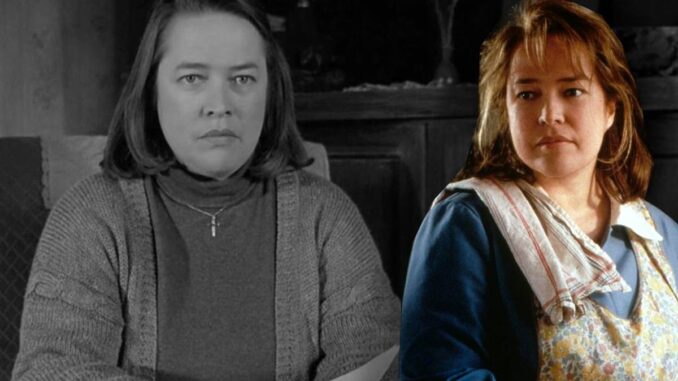
From “Misery” to Matlock: How Kathy Bates Conquered the Audience Over 30 Years
Kathy Bates isn’t your typical Hollywood leading lady. She isn’t a waifish ingénue or a statuesque beauty. Instead, she’s a woman with a relatably robust figure, a genuine warmth that radiates from her eyes, and a raw, undeniable talent that has allowed her to traverse genres and decades, captivating audiences from the terrifying depths of “Misery” to the comforting familiarity of “Matlock.” Over the last 30 years, Bates has forged a path of authenticity and versatility, showcasing a chameleon-like ability to embody characters both horrifying and heartwarming, ultimately solidifying her position as a beloved and respected figure in entertainment.
The earthquake that shook the industry, and perhaps more importantly, introduced Bates to a wider audience, was her Oscar-winning performance as Annie Wilkes in the 1990 adaptation of Stephen King’s “Misery.” Here, Bates transcended the horror genre, delivering a nuanced and terrifying portrayal of a woman whose obsessive love twisted into violent madness. Annie wasn’t just a caricature of a psycho; she was a complex character with vulnerabilities, anxieties, and a chillingly warped sense of morality. Bates imbued her with a disarming folksiness that made the sudden bursts of rage and brutality all the more shocking. The hammer scene, a moment forever etched in cinematic history, wouldn’t have had the same impact without Bates’ masterful portrayal of the seemingly harmless woman who wielded it. “Misery” wasn’t just a horror film; it was a showcase of Bates’ exceptional acting prowess, revealing her ability to explore the darkest corners of the human psyche with unsettling believability.
The immediate impact of “Misery” could have typecast Bates in similar roles. However, she wisely chose a different path, demonstrating her range with roles in comedies like “Fried Green Tomatoes” (1991) and “Dolores Claiborne” (1995). In “Fried Green Tomatoes,” she played Evelyn Couch, a timid housewife who finds her inner strength by listening to the stories of an older woman. This role allowed Bates to showcase her comedic timing and her ability to portray vulnerability with genuine heart. “Dolores Claiborne,” another King adaptation, offered a different kind of depth, allowing Bates to explore themes of maternal sacrifice and unspoken pain. These choices demonstrated that Bates was not simply a one-dimensional villain; she was a versatile actress capable of embodying a wide spectrum of human emotions.
The late 90s and early 2000s saw Bates continue to expand her repertoire, taking on roles that ranged from the eccentric Libby Holden in “Primary Colors” (1998), earning another Oscar nomination, to the flamboyant Molly Brown in “Titanic” (1997), further solidifying her mainstream appeal. She navigated the world of independent cinema with ease, embracing roles that challenged her and allowed her to delve deeper into complex characters. This era solidified her reputation as a character actress with leading-lady potential, a rare and coveted position in Hollywood.
As she transitioned into television, Bates continued to choose roles that challenged her and captivated audiences. Her Emmy-winning guest appearance on “Two and a Half Men” showed her comedic brilliance. She then fully embraced the world of television with roles in “Harry’s Law” and, perhaps most notably, in Ryan Murphy’s anthology series, “American Horror Story.” This partnership proved to be a perfect match. Murphy recognized Bates’ ability to embody both the terrifying and the sympathetic, creating roles that were tailor-made for her talents. Her performances as Delphine LaLaurie, Iris, and Ethel Darling were both chilling and deeply moving, allowing her to explore the themes of prejudice, addiction, and the desperate search for acceptance. These roles allowed her to connect with a new generation of viewers who were captivated by her ability to bring depth and nuance to even the most outlandish characters.
While “American Horror Story” solidified her status as a modern icon, her recent appearance in the rebooted “Matlock” as the titular Madeline “Matty” Matlock shows her enduring appeal and unwavering ability to resonate with audiences of all ages. Playing a quirky and brilliant attorney, Bates brings her signature warmth and wit to the role, reminding us that she is not only a force to be reckoned with in dramatic roles, but also a gifted comedic performer.
Kathy Bates’ journey over the last 30 years has been a testament to her talent, her versatility, and her unwavering commitment to authenticity. From the terrifying Annie Wilkes to the comforting Matty Matlock, she has consistently delivered performances that are both captivating and deeply human. She has proven that success in Hollywood doesn’t require fitting into a pre-defined mold. Instead, it requires embracing one’s unique talents, choosing roles that challenge and inspire, and connecting with audiences on a genuine and emotional level. Kathy Bates has done all of this and more, solidifying her place as a true icon of the screen and a beloved figure in the hearts of audiences around the world. Her journey is a celebration of talent, perseverance, and the enduring power of authentic storytelling.
